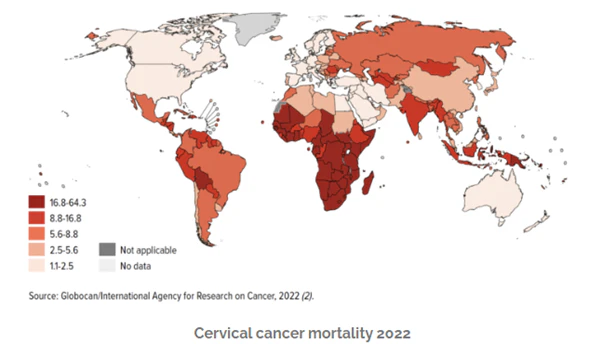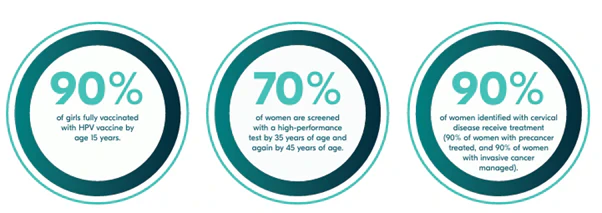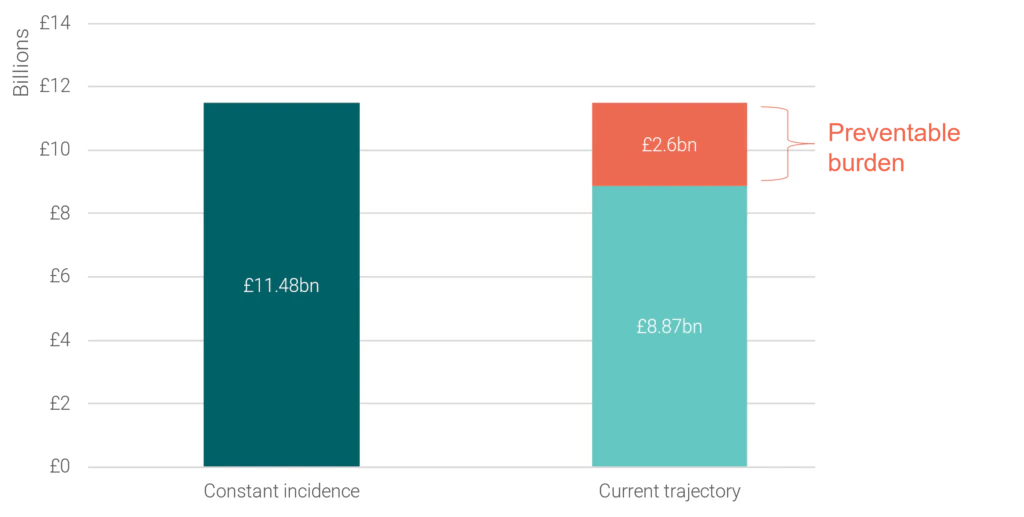Introduction
Cervical cancer remains a significant public health challenge, particularly in low- and middle-income countries (LMICs), where access to preventive measures, screening, and treatment is limited. Although the disease is largely preventable through vaccination against the human papillomavirus (HPV), the primary cause of cervical cancer, it continues to claim the lives of approximately 350,000 women globally each year (1).In response to this ongoing crisis, the World Health Organization (WHO) has set ambitious targets to eliminate cervical cancer as a public health problem by 2030, focusing on vaccination, screening, and treatment (2). Therefore, this Insight Article explores the current landscape of cervical cancer prevention and treatment, highlighting innovations and challenges, and discusses the future directions needed to achieve global elimination.
The Global Burden of Cervical Cancer
Cervical cancer is the fourth most common cancer in women worldwide, with 660,000 new cases diagnosed in 2022 (3,4). Moreover, the disease disproportionately affects women in LMICs, where over 90% of cervical cancer deaths occur, largely due to inadequate access to health services (5). Cervical cancer incidence and mortality are highest in sub-Saharan Africa, Central America, and Southeast Asia (4,6). These regional disparities in cervical cancer burden are influenced by unequal access to vaccination, screening, and treatment services, as well as risk factors like HIV prevalence. However social and economic determinants, including gender biases and poverty, also contribute to these differences (6). In sub-Saharan Africa, the burden is exacerbated by high HIV prevalence, which increases the risk of invasive cervical cancer by six-fold (5). For example, in countries like Indonesia, cervical cancer is the second most common cancer among women, with about 36,000 new cases and 21,000 deaths annually (3).

HPV Vaccination Innovations
The introduction of the HPV vaccine has been a pivotal development in cervical cancer prevention. As of 2024, 141 countries have integrated the HPV vaccine into their national immunisation programs, with 59 adopting a single-dose policy, including South Africa, Canada, the United Kingdom and Australia, which WHO recommends for its comparable protection and cost-effectiveness (3). This shift aims to increase coverage, particularly in LMICs, where logistical and financial barriers have hindered two-dose schedules.
Enhancing public awareness, access to information, and services remain key to prevention and control across the life course. Vaccination at ages 9–14 is highly effective in preventing HPV infection, cervical cancer, and other HPV-related cancers (6,7). As of 2023, six globally available HPV vaccines protect against the high-risk HPV types 16 and 18, which are responsible for most cervical cancers (6). These vaccines are safe and effective, and a single-dose regimen has proven to be an innovative step toward improving accessibility and affordability.
The WHO Global Strategy for cervical cancer elimination as a public health problem (3,8), set for 2030, establishes ambitious targets to reduce the disease burden worldwide. These global targets require:
- 90% of girls to be vaccinated with the HPV vaccine by age 15,
- 70% of women to be screened with a high-performance test by ages 35 and 45,
- 90% of women with pre-cancer to receive treatment and 90% of women with invasive cancer to be managed.

Comparative Insights
Countries like Indonesia and Nigeria have made significant strides in expanding HPV vaccine access. For instance, Indonesia’s 2023 national rollout aligns with the WHO strategy, aiming for 90% coverage of girls by age 15 (1). Similarly, Nigeria’s adoption of the single-dose schedule seeks to achieve at least 80% coverage by 2026, focusing on school-based delivery and outreach activities (1,8). Meanwhile, in the Americas, the Pan American Health Organization (PAHO) has emphasised the need for comprehensive programs to expand HPV vaccination coverage, implement HPV testing, and increase access to treatment for precancerous lesions and invasive cancer (10). In line with efforts in Indonesia and Nigeria, PAHO has highlighted that adopting single-dose HPV vaccination schedules, particularly in schools, and using HPV tests widely are key measures to address cervical cancer and ensure the Americas are at the forefront of elimination efforts.
Advances in Screening and Treatment
Screening for cervical cancer has traditionally relied on pap smears; however, innovations such as HPV DNA testing and self-collection kits are transforming early detection (11,12). For instance, Roche’s FDA-approved HPV self-collection solution allows women to privately collect samples, thereby increasing access and potentially reducing barriers related to healthcare access and cultural concerns (13). Moreover, these advancements, coupled with the introduction of the human papillomavirus (HPV) vaccine, represent significant progress in reducing the global burden of cervical cancer. Not only do they enhance early detection capabilities, but they also address critical barriers to access, particularly for underserved populations. Consequently, these developments are pivotal in the ongoing efforts to improve public health outcomes.
Economic Burden of Cervical Cancer in LMICs
Cervical cancer imposes significant economic and financial burdens globally, especially in LMICs, where inadequate healthcare infrastructure and limited access to prevention further exacerbate costs. Moreover, women diagnosed with cervical cancer often face severe financial challenges, including income loss due to employment barriers and substantial out-of-pocket expenses for treatment. Consequently, these burdens extend to families, as many affected women are primary earners, thereby threatening household financial security and the education of their children (14). For instance, productivity losses account for up to 63% of the economic burden per case in some settings, thereby emphasising the broader societal impact of the disease (15).
Cost-Effective Innovations in Cervical Cancer
Innovations in cervical cancer prevention, such as HPV DNA testing, have proven highly cost-effective. As a result, reducing mortality and long-term treatment costs by enabling early detection and intervention. Specifically, HPV testing demonstrates incremental cost-effectiveness ratios (ICERs) below GDP per capita in LMICs. Therefore, offering a sustainable and efficient alternative to cytology-based methods, which are less effective and more resource-intensive (14,16). Moreover, self-collected HPV testing improves access by reducing stigma and infrastructure barriers, enhancing population coverage and cost-efficiency (16). Achieving elimination targets, such as those proposed by the WHO, could significantly alleviate the socioeconomic burden of cervical cancer. For instance, in the UK, achieving elimination by 2046 could save approximately £2.6 billion (15), demonstrating that the global economic impact of cervical cancer is largely preventable with strategic investments in vaccination, screening, and treatment programs. Addressing this economic burden requires coordinated efforts to implement cost-effective strategies and strengthen healthcare systems worldwide.

Barriers to Effective Screening and Vaccination
However, despite these advances, currently less than 5% of women in many LMICs are ever screened for cervical cancer. (1). Therefore, efforts to integrate screening with routine health services, as seen in Unitaid and Gavi’s pilot programs in Côte d’Ivoire and Nigeria, are crucial for improving coverage (5). Specifically, these programs leverage community-based screening and innovative delivery models to reach underserved populations. Meanwhile, in the Americas, only four countries in Latin America and the Caribbean have incorporated HPV testing into their national health systems, emphasising the need for expanded screening efforts (10).
Global Efforts and Strategic Goals for Elimination
Overall, the path to eliminating cervical cancer is fraught with challenges, including supply constraints, health system limitations, and socio-economic barriers. Furthermore, the COVID-19 pandemic has exacerbated these issues by disrupting vaccination and screening efforts. As a result, only one in five eligible adolescent girls was vaccinated in 2022. (1). Therefore, by addressing these issues requires coordinated global efforts, as evidenced by the nearly US$ 600 million in new funding announced at the Global Cervical Cancer Elimination Forum in 2024 (1,8). In fact, all countries have made a commitment to eliminate cervical cancer as a public health problem. The WHO Global Strategy defines elimination as reducing the number of new cases annually to 4 or fewer per 100,000 women and sets three targets to be achieved by the year 2030 to put all countries on the pathway to elimination in the coming decades.
Moreover, modelling estimates suggest that by reaching this elimination goal, a cumulative 74 million new cases of cervical cancer can be averted 62 million deaths can be avoided by 2120 (17). In the Americas, PAHO has committed to working closely with member states to accelerate the implementation of strategies that will contribute to the region being the first in the world to reach the 90-70-90 targets by 2030 (10). This includes offering HPV vaccines, tests, and treatment devices through PAHO’s funds at a consistent price, regardless of purchase size. Furthermore, by maintaining this pricing strategy, it ensures equitable access for all member countries, thereby promoting widespread immunization and treatment efforts.
Conclusion
In conclusion, eliminating cervical cancer is within reach; however, it requires sustained innovation, investment, and commitment from all stakeholders. Therefore, to achieve this goal, it is essential to enhance HPV vaccination access and improve screening. Furthermore, as we approach the 2030 targets, maintaining momentum is crucial to ensure that no woman is left behind. Consequently, by working together and prioritizing these efforts, we can make cervical cancer a disease of the past.
References
- Wave of new commitments marks historic step towards the elimination of cervical cancer [Internet]. [cited 2025 Jan 27]. Available from: https://www.who.int/news/item/05-03-2024-wave-of-new-commitments-marks-historic-step-towards-the-elimination-of-cervical-cancer
- As Development Of Therapeutic Vaccines Against Cervical Cancer Virus Gain Momentum, WHO Issues Product Guidelines – Health Policy Watch [Internet]. 2024 [cited 2025 Jan 27]. Available from: https://healthpolicy-watch.news/with-20-potential-vaccines-to-treat-virus-causing-cervical-cancer-who-issues-product-guidelines/
- WHO, UNFPA commend Indonesia’s efforts to eliminate cervical cancer, urge streamlined vaccine strategy and enhanced screening [Internet]. [cited 2025 Jan 27]. Available from: https://www.who.int/indonesia/news/detail/15-11-2024-who–unfpa-commend-indonesia-s-efforts-to-eliminate-cervical-cancer–urge-streamlined-vaccine-strategy-and-enhanced-screening
- Carapinha JL. Cervical Cancer Burden: Global Trends and Future Projections [Internet]. Syenza News. 2025 [cited 2025 Jan 28]. Available from: https://news.syenza.com/cervical-cancer-burden-global-trends-future-projections/
- Unitaid and Gavi establish new partnership to improve access to cervical cancer prevention [Internet]. [cited 2025 Jan 27]. Available from: https://www.gavi.org/news/media-room/unitaid-and-gavi-establish-new-partnership-improve-access-cervical-cancer
- Cervical cancer [Internet]. [cited 2025 Jan 27]. Available from: https://www.who.int/news-room/fact-sheets/detail/cervical-cancer
- Lubbe C. HPV vaccination South Africa: Cervical Cancer Prevention [Internet]. Syenza News. 2024 [cited 2025 Jan 28]. Available from: https://news.syenza.com/hpv-vaccination-south-africa-model-for-cervical-cancer-prevention/
- Carapinha JL. WHO Introduces HPV Single-Dose Vaccine to Boost Cervical Cancer Elimination Efforts [Internet]. Syenza News. 2024 [cited 2025 Jan 28]. Available from: https://news.syenza.com/who-introduces-single-dose-hpv-vaccine-to-boost-cervical-cancer-elimination/
- Global Strategy to Accelerate the Elimination of Cervical Cancer as a Public Health Problem. [Internet]. [cited 2025 Jan 27]. Available from: https://www.who.int/publications/i/item/9789240014107
- Accelerating access to HPV vaccination, screening and ablative treatment of lesions key to addressing cervical cancer in the Americas, PAHO Director says – PAHO/WHO | Pan American Health Organization [Internet]. 2024 [cited 2025 Jan 27]. Available from: https://www.paho.org/en/news/2-10-2024-accelerating-access-hpv-vaccination-screening-and-ablative-treatment-lesions-key
- Pretorius R. Cost-Effective Cervical Cancer Screening Strategies for Women with HIV in KwaZulu-Natal [Internet]. Syenza News. 2025 [cited 2025 Jan 28]. Available from: https://news.syenza.com/cost-effective-cervical-cancer-screening/
- Pretorius R. Advances in Cervical Cancer Screening: HPV Self-Collection Tests [Internet]. Syenza News. 2024 [cited 2025 Jan 28]. Available from: https://news.syenza.com/improving-cervical-cancer-screening-hpv-self-collection-tests/
- Roche announces FDA approval of one of the first HPV self-collection solutions in the U.S., expanding access and screening options to help eliminate cervical cancer [Internet]. [cited 2025 Jan 27]. Available from: https://www.roche.com/media/releases/med-cor-2024-05-15
- Casas CPR, Albuquerque R de CR de, Loureiro RB, Gollner AM, Freitas MG de, Duque GP do N, et al. Cervical cancer screening in low- and middle-income countries: A systematic review of economic evaluation studies. Clinics. 2022 Jan 1;77:100080. Avaliable from: https://doi.org/10.1016/j.clinsp.2022.100080
- Writer S. The Socioeconomic Impact of Cervical Cancer in the UK [Internet]. Syenza News. 2024 [cited 2025 Jan 28]. Available from: https://news.syenza.com/the-socioeconomic-impact-of-cervical-cancer-in-the-uk/
- Mezei AK, Armstrong HL, Pedersen HN, Campos NG, Mitchell SM, Sekikubo M, et al. Cost-effectiveness of cervical cancer screening methods in low- and middle-income countries: A systematic review. International Journal of Cancer. 2017;141(3):437–46. Avaliable from: https://doi.org/10.1002/ijc.30695
- Global strategy to accelerate the elimination of cervical cancer as a public health problem [Internet]. [cited 2025 Jan 27]. Available from: https://www.who.int/publications/i/item/9789240014107
Table of Contents

